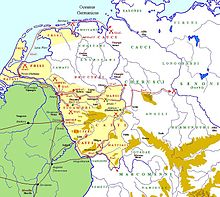The Battle of Arbalo fought between the Romans and the Germani in 11 BC. It was part of the Drusus' campaigns (12–8 BC). This campaign started with the unstable north of the Roman Empire near Gaul, with the Germanic from the east of Gaul constantly attacking Rome, Augustus would send Drusus.
| Battle of Arbalo | |||||||
|---|---|---|---|---|---|---|---|
| Part of the Early campaigns in Germania Campaigns of Drusus and Roman–Germanic Wars | |||||||
 Campaigns of Drusus | |||||||
| |||||||
| Belligerents | |||||||
| Roman Empire |
Allied Germanic peoples, possibly including the: | ||||||
| Commanders and leaders | |||||||
| Drusus | Unknown, possibly Segimer | ||||||
| Strength | |||||||
| 19,200–41,600 (estimated) | 10,000–20,000 (estimated) | ||||||
| Casualties and losses | |||||||
| 1,000–3,000 (estimated) | 2,000–5,000 (estimated) | ||||||
As part of operations by Augustus to secure the borders of the Roman Empire, Drusus, military commander and stepson of Augustus, was given the order to pacify the region on either side of the River Rhine. In spring 11 BC. he crossed the Rhine with his army and defeated the Usipetes. He built a bridge over the Lippe and marched through the territory of the Sugambri and the Cherusci to the Weser.

During its return march to the Rhine the army was lured into an ambush at a place called Arbalo.[1] It was attacked in a narrow pass by Cherusci.[2]
Using the element of surprise and their advantageous position, the Germans were winning until they decided to retreat for some time, allowing the Romans to break through the force defending one of the exits and escape.[2] After the battle, Drusus would build a fortified fort where the battle take place.[3] However, only 2 years after the battle of Arbalo, Drusus would pass away after falling off a horse.[4]
Arbalo is thought to be near modern-day Hameln or Hildesheim.[2] At the end of the campaign, The Roman was able to secure their lands to the north.

- ^ Titus Livius, periocha 140: Cherusci Tencteri Chauci aliaeque Germanorum trans Rhenum gentes subactae a Druso referuntur.
- ^ a b c Powell, Lindsay (2013). Eager for glory : the untold story of Drusus the Elder, Conqueror of Germania (1 ed.). Barnsley: Pen & Sword Books Ltd. pp. Chapter 5: “Drusus the commander”, Section “Ambush at Arbalo”. ISBN 978-1-78303-003-3. OCLC 835973451.
- ^ "Battle of Arbalo". Alisonensis. Retrieved 2022-12-09.
- ^ "Gale - Product Login".
